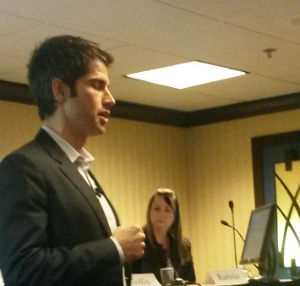 If there’s one thing I’ve heard non-stop lately it’s that digital marketing is becoming more customized and tailored to the wants and needs of consumers. Those creepy Eye See You Mannequins, facial monitoring at gas stations, and those social ads that somehow know that I was shopping for a watch yesterday are all proof that brands are able to cater their advertisements to appeal to something we’re actually going to be motivated to buy.
If there’s one thing I’ve heard non-stop lately it’s that digital marketing is becoming more customized and tailored to the wants and needs of consumers. Those creepy Eye See You Mannequins, facial monitoring at gas stations, and those social ads that somehow know that I was shopping for a watch yesterday are all proof that brands are able to cater their advertisements to appeal to something we’re actually going to be motivated to buy.
This has created a unique opportunity for marketers: enhanced Google AdWords campaigns which were launched on July 22nd of this year.
In their SES Chicago session, Michael Griffin and Lisa Raehsler reviewed what those campaigns are and how to design, segment, and optimize one. Here are some of the key takeaways from their session:
User Habits Have Changed
A lot of the sessions at SES have been talking about the fact we like to multitask on several devices. Searchers shift between mobile devices like tablets and smartphones, desktops, and laptops simultaneously. So marketers have to stop thinking of things in a channel-centric way, and start thinking (and creating content and design) in terms of all devices. It is also important to become much more strategic in targeting and ad campaigns to help attract and engage multidevice users.
Marketers Need a New Mindset
Search is no longer all about keywords. It’s important to shift your mindset to knowing your customer deeply and leveraging the tools Google gives you to appeal to those customers. The days of mass creation are over–we’re transitioning into a time when customization, personalization, and relevance will make or break the success of your content. Leveraging this data can help you provide the right message to the right people at the right time.
Calculate Bid Modifiers
There is data out there to help you understand your customers at the zip code level, the city level and the state level to help you maximize the impact of your enhanced ad campaign. Bid modifiers are a great way to tailor your campaign to reach the people who it is most relevant to, and who will likely click on your ads. However, like most things, there is some debate over how to calculate the bid modifiers for an AdWords campaign. The formula the presenters recommend is: [(Revenue per click for a segment divided by revenue per click of the whole) minus 1] * 100.
Use Remarketing Lists for Search Ads (RLSA)
This new feature allows you to create different audiences based on the value you think they might have. You can bid on those people in Google search results differently helping customize your ads. Segmenting on granular level has proven to bring the best results when leveraging this new capability. This deeper level of segmentation will allow you to guide those searchers to where you want them to go on your site, and help make those landing destinations more relevant.
This works well for eCommerce sites by adding value to the items in a shopper’s cart and targeting based on the value of the total items in their cart. The only limitation to this capability is that 1,000 people have to be in a segment for you to bid on it.
Mobilize Your Campaigns
Design ads that are mobile preferred. This will require specific imagery and a tailored call to action that’s easy for mobile users to complete and that assures them it really is ok to click. With the impressive surge in mobile usage, it is important to convey your messages to the mobile users that are visiting your site.
Follow an Action Plan for Capturing Opportunity
When faced with an opportunity, it’s important to not only capture it but to bring it full circle to enhance mobile experiences. Raehsler provided the following action plan for helping brands do so:
- Increase bid modifier for mobile to increase visibility
- Increase bid modifier on top states
- Create ad copy to mobile + location
Use Data to Craft Mobile Adjustments, Targeting and Experience
There is an abundance of data in anything related to Google. Google Analytics can help you see whether or not people are engaged with what you’re showing them based off of how much time they’re spending on your site, how many pages they look at etc. In AdWords you can break down your insights by gender and age. Seeing who is more likely to visit your site can help you target a more engaged user.
Don’t Limit Yourself to AdWords Enhanced Campaigns only
Did you know Bing had enhanced campaigns? Yeah I didn’t either, but they do. They also allow deeper segmentation and more filtering. Don’t limit yourself to using only Google enhanced campaigns, there’s no reason you can’t use both.
Get to Know Bid Strategies
There are 5 bid strategies when it comes to enhanced AdWords campaigns. The last two in the list below are the newest, and most impressive, of the strategies.
- Maximize Clicks: this is a flexible version of the Automatic CPC bidding strategy
- CPA Bidding: this is a flexible version of Conversion Optimizer used in the target CPA (average CPA) capacity
- Enhanced CPC: this is a flexible version of the existing enhanced CPC capability
- Search Page Location: AdWords will increase/decrease bids to target a top-of-page or fist page position with ads. This bid strategy works with Search Network only and doesn’t specify a position on the page (so you can’t choose to be in the second, third, fourth position on the page etc.)
- Return on Ad Spend (ROAS): AdWords predicts future conversions and values based on conversion values advertisers set up. Used for Search Network only or the Search Display Networks, Adwords will try to reach the ROAS targets across all keywords, ad groups, and campaigns.
Use PPC/display results to further design & author
Ad campaigns aren’t a one-and-done type deal. Use consumer reactions and the results you see through analytics to tweak, redesign, and rewrite your content to continuously appeal to audiences and maintain relevance.


